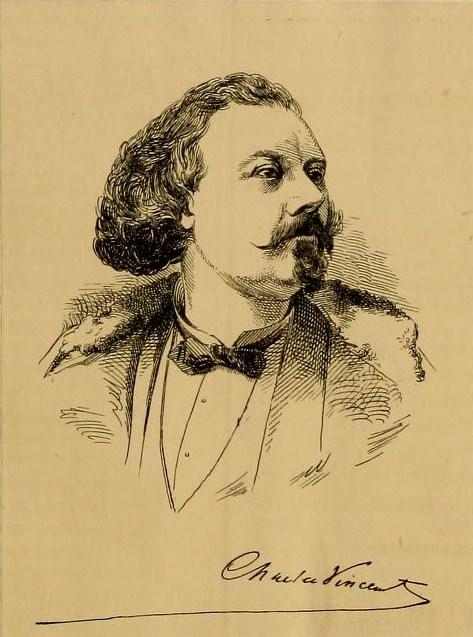Charles Vincent (playwright) on:
[Wikipedia]
[Google]
[Amazon]
 Charles Hubert Vincent (
Charles Hubert Vincent (
''Album révolutionnaire''
Paris, 1849.
''L'Enfant du Tour de France''
Paris, 1857. * ''La Crème des domestiques'', Paris, 1858. * ''Chansons mois et toasts'', E. Dentu, Éditeur, Paris, 1882.
Charles Vincent (1826–1888)
on data.bnf.fr
''Charles Vincent, publiciste et homme de lettres''
''Charles Vincent, président du Caveau''
{{DEFAULTSORT:Vincent, Charles French chansonniers 19th-century French journalists French male journalists French publishers (people) 19th-century French novelists 19th-century French dramatists and playwrights 1828 births People from Fontainebleau 1888 deaths 19th-century French male writers
 Charles Hubert Vincent (
Charles Hubert Vincent (Fontainebleau
Fontainebleau (; ) is a commune in the metropolitan area of Paris, France. It is located south-southeast of the centre of Paris. Fontainebleau is a sub-prefecture of the Seine-et-Marne department, and it is the seat of the ''arrondissement ...
, 15 April 1828 – 16 August 1888) was a 19th-century French playwright, chansonnier
A chansonnier ( ca, cançoner, oc, cançonièr, Galician and pt, cancioneiro, it, canzoniere or ''canzoniéro'', es, cancionero) is a manuscript or printed book which contains a collection of chansons, or polyphonic and monophonic settings o ...
, goguettier, novelist, journalist and publisher.
Biography
Coming from a family of four generations of wig makers, he left the Graduate School of Fontainebleau at the age of thirteen and engaged in several little jobs. He was alternatively a notary and "avoué
During the Middle Ages, an (sometimes given as modern English: advocate; German: ; French: ) was an office-holder who was legally delegated to perform some of the secular responsibilities of a major feudal lord, or for an institution such as ...
" clerk. In 1840, he moved to Paris as upholsterer and then worked as traveling salesman.
During the French Revolution of 1848
The French Revolution of 1848 (french: Révolution française de 1848), also known as the February Revolution (), was a brief period of civil unrest in France, in February 1848, that led to the collapse of the July Monarchy and the foundation ...
, Charles attracted attention with his revolutionary poems, published in 1849 under the title ''Album révolutionnaire. Chants démocratiques''.
In 1850, he definitively settled in Paris, and from singing to political meetings, he naturally came to journalism and songwriting. Charles Vincent became famous.
He wrote many novels, poems and songs, including the collection titled ''Refrains du dimanche'' (Paris, 1856), composed in collaboration with Édouard Plouvier and illustrated by Gustave Doré
Paul Gustave Louis Christophe Doré ( , , ; 6 January 1832 – 23 January 1883) was a French artist, as a printmaker, illustrator, painter, comics artist, caricaturist, and sculptor. He is best known for his prolific output of wood-engraving ...
. In 1860, he published ''Histoire de la chaussure et des cordonniers'', and several novels.
As a journalist, he collaborated with ''Le Siècle
''Le Siècle'' ("''The Age''") is a daily newspaper that was published from 1836 to 1932 in France.
History
In 1836, ''Le Siècle'' was founded as a paper that supported constitutional monarchism. However, when the July Monarchy came to an end ...
'' and founded ''Le Moniteur de la cordonnerie'', which frequently paid its editors with shoes ... ''La Halle aux cuirs'' was one of the first technical journal in the French press.
He established or directed several fashion magazines: ''L'Illustrateur des dames'', ''La Joie du foyer'', ''La Boîte à ouvrage'', etc. He was a pioneer in the specialized press and all his ventures prospered.
He also authored ''L'Enfant du Tour de France'', five-act drama given in 1857, as well as one vaudeville
Vaudeville (; ) is a theatrical genre of variety entertainment born in France at the end of the 19th century. A vaudeville was originally a comedy without psychological or moral intentions, based on a comical situation: a dramatic composition ...
, ''La Crème des domestiques'', in 1858.
The child of the Revolution of 1848 made thus a fortune under the Second French Empire
The Second French Empire (; officially the French Empire, ), was the 18-year Empire, Imperial Bonapartist regime of Napoleon III from 14 January 1852 to 27 October 1870, between the French Second Republic, Second and the French Third Republic ...
but remained true to songwriting throughout his life.
In 1878, 1881, 1883 and 1886, Charles Vincent was elected president of the famous Parisian goguette
A Goguette was a singing society in France and Belgium, and its members were called ''goguettiers''. As well as providing venues for informal solo and ensemble singing, goguettes also served as places for drinking, socialising, and recreation.
Gog ...
, the '' Caveau'', the fourth of its name.
Some works
''Album révolutionnaire''
Paris, 1849.
''L'Enfant du Tour de France''
Paris, 1857. * ''La Crème des domestiques'', Paris, 1858. * ''Chansons mois et toasts'', E. Dentu, Éditeur, Paris, 1882.
References
External links
Charles Vincent (1826–1888)
on data.bnf.fr
''Charles Vincent, publiciste et homme de lettres''
''Charles Vincent, président du Caveau''
{{DEFAULTSORT:Vincent, Charles French chansonniers 19th-century French journalists French male journalists French publishers (people) 19th-century French novelists 19th-century French dramatists and playwrights 1828 births People from Fontainebleau 1888 deaths 19th-century French male writers